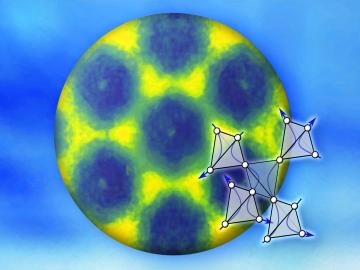
Filter News
Area of Research
- (-) Energy Science (80)
- (-) National Security (21)
- (-) Neutron Science (39)
- Advanced Manufacturing (2)
- Biological Systems (1)
- Biology and Environment (68)
- Biology and Soft Matter (1)
- Building Technologies (3)
- Computational Biology (2)
- Computational Engineering (3)
- Computer Science (9)
- Electricity and Smart Grid (1)
- Energy Frontier Research Centers (1)
- Functional Materials for Energy (1)
- Fusion and Fission (11)
- Fusion Energy (7)
- Isotopes (7)
- Materials (89)
- Materials for Computing (10)
- Mathematics (1)
- Nuclear Science and Technology (15)
- Nuclear Systems Modeling, Simulation and Validation (1)
- Quantum information Science (9)
- Supercomputing (99)
News Topics
- (-) Advanced Reactors (7)
- (-) Biomedical (21)
- (-) Buildings (38)
- (-) Exascale Computing (2)
- (-) Machine Learning (21)
- (-) Nanotechnology (18)
- (-) Physics (11)
- (-) Quantum Science (9)
- 3-D Printing/Advanced Manufacturing (85)
- Artificial Intelligence (25)
- Big Data (13)
- Bioenergy (33)
- Biology (20)
- Biotechnology (6)
- Chemical Sciences (17)
- Clean Water (10)
- Composites (18)
- Computer Science (50)
- Coronavirus (24)
- Critical Materials (9)
- Cybersecurity (25)
- Energy Storage (74)
- Environment (64)
- Fossil Energy (3)
- Frontier (3)
- Fusion (3)
- Grid (43)
- High-Performance Computing (12)
- Hydropower (3)
- Isotopes (1)
- Materials (47)
- Materials Science (49)
- Mathematics (3)
- Mercury (3)
- Microelectronics (1)
- Microscopy (10)
- Molten Salt (1)
- National Security (37)
- Neutron Science (121)
- Nuclear Energy (13)
- Partnerships (16)
- Polymers (12)
- Quantum Computing (1)
- Security (16)
- Simulation (4)
- Space Exploration (6)
- Statistics (1)
- Summit (10)
- Transportation (70)
Media Contacts

A new method developed at Oak Ridge National Laboratory improves the energy efficiency of a desalination process known as solar-thermal evaporation.

Scientists have discovered a way to alter heat transport in thermoelectric materials, a finding that may ultimately improve energy efficiency as the materials

An ORNL-led team's observation of certain crystalline ice phases challenges accepted theories about super-cooled water and non-crystalline ice. Their findings, reported in the journal Nature, will also lead to better understanding of ice and its various phases found on other planets, moons and elsewhere in space.

OAK RIDGE, Tenn., March 20, 2019—Direct observations of the structure and catalytic mechanism of a prototypical kinase enzyme—protein kinase A or PKA—will provide researchers and drug developers with significantly enhanced abilities to understand and treat fatal diseases and neurological disorders such as cancer, diabetes, and cystic fibrosis.

![Coexpression_hi-res_image[1].jpg Coexpression_hi-res_image[1].jpg](/sites/default/files/styles/list_page_thumbnail/public/Coexpression_hi-res_image%5B1%5D_0.jpg?itok=ww635BCP)
While studying the genes in poplar trees that control callus formation, scientists at Oak Ridge National Laboratory have uncovered genetic networks at the root of tumor formation in several human cancers.

Researchers used neutron scattering at Oak Ridge National Laboratory’s Spallation Neutron Source to investigate bizarre magnetic behavior, believed to be a possible quantum spin liquid rarely found in a three-dimensional material. QSLs are exotic states of matter where magnetism continues to fluctuate at low temperatures instead of “freezing” into aligned north and south poles as with traditional magnets.

A team of scientists has for the first time measured the elusive weak interaction between protons and neutrons in the nucleus of an atom. They had chosen the simplest nucleus consisting of one neutron and one proton for the study.

To learn more about interactions between drug molecules and micelles, Associate Professor Megan Robertson and graduate students Tyler Cooksey and Tzu-Han Li from the University of Houston (UH) are using neutrons at the Department of Energy’s (DOE’s) Oak Ridge National Laboratory (ORNL).
![2018-P07635 BL-6 user - Univ of Guelph-6004R_sm[2].jpg 2018-P07635 BL-6 user - Univ of Guelph-6004R_sm[2].jpg](/sites/default/files/styles/list_page_thumbnail/public/2018-P07635%20BL-6%20user%20-%20Univ%20of%20Guelph-6004R_sm%5B2%5D.jpg?itok=hUSyvkP0)
A team of scientists, led by University of Guelph professor John Dutcher, are using neutrons at ORNL’s Spallation Neutron Source to unlock the secrets of natural nanoparticles that could be used to improve medicines.


